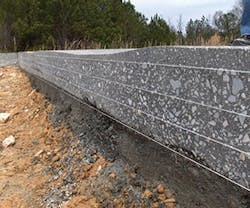Green Your Asphalt Parking Lot
Can your asphalt parking lot last 50 years?
Most facility managers are unaware that asphalt pavement can have a service life of more than five decades with the appropriate design, good construction practices, and timely preventive maintenance.
Called perpetual pavement, this design and rehabilitation approach provides a sustainable strategy that extends the lifecycle and performance of your asphalt while decreasing reconstruction costs and natural resources.
Proper Pavement Design
According to the National Asphalt Pavement Association, perpetual pavement is “an asphalt pavement designed and built to last longer than 50 years without requiring major structural rehabilitation or reconstruction and needing only periodic surface renewal in response to distresses confined to the top of the pavement.”
Following good pavement design practices helps your asphalt reach its design service life. In far too many cases, the general practice is to use the same specification regardless of goals, budget, available materials, location, environment, subbase, or traffic use.
For your perpetual pavement to meet your goals, you must first address the structure and foundation, which work in conjunction to allow the pavement to be perpetual. A proper base will allow you to resurface as needed for added years of service.
Pavement Foundation
The key to long-term performance of any pavement system is a solid foundation. Without the right base, the upper layers of a perpetual pavement system
are bound to fail.
Two areas of failure that need to be accounted for are structural rutting and fatigue cracking. Structural rutting occurs when the overall strength of the pavement has degraded to the point that deformations can take place in all of the asphalt layers and even transfer into the crushed aggregate base or the subgrade layer.
Fatigue cracking is also evident in today’s traditional pavements. This failure is when cracking occurs from the bottom up through the surface course. This can lead to pumping, rutting, and accelerated surface deterioration.
A properly designed foundation consists of a variety of components, such as modified or unmodified soils or crushed aggregate and recycled products like crushed concrete or milled asphalt. PageBreak
Asphalt Pavement Structure
An asphalt pavement structure consists of three layers. The surface course asphalt can be a stone matrix mix, a dense-graded mix, or an open graded friction course.
The key to the right mix is knowledge of the traffic conditions, environment, and local experience – there needs to be resistance to rutting and surface cracking. Other properties such as good friction, reduction of tire-pavement noise, and mitigation of splash and spray are critical as well.
The intermediate course must combine stability and durability to be deemed perpetual. Using a high temperature binder and achieving stone-on-stone contact of the coarse aggregate in the mix will lead to the needed combination.
The same binder for this layer needs to be incorporated and used in the surface layer as well. Special attention should also be emphasized on the air void level, which should have a lower level to guard against water permeability.
The lower course of asphalt needs to resist fatigue cracking caused by repeated traffic loads. The simplest mix adjustment is to increase the asphalt content by adding more binder. This step improves durability and fatigue resistance by forming a higher density during installation.
Combined with the additional asphalt thicknesses, the increased density also provides more flexibility, which means the pavement is less likely to crack from the bottom up.
Perpetual Cost Savings
Upfront costs associated with perpetual pavement are typically more than conventional asphalt pavement. Depending on the design requirements and total pavement thickness, the initial investment for this method can be between 20-50% higher.
The real value is achieved when it is time to rehabilitate the pavement, which only requires milling off the top few inches of the surface layer to remove any rutting or surface cracking and installing a new surface or wearing course.
With perpetual pavement, you will only need to restore your surface two or three times over the 50-year lifespan, as opposed to a complete replacement after 15-20 years of use. The cost of a pavement overlay can range from 65-80% less than pavement reconstruction.
If the budget costs for the initial investment are too high, one option is to design the first rehabilitation overlay earlier in the pavement life, such as at 10 years instead of 15-20 years.
You can then plan to increase the wearing course thickness by an inch or two during the first overlay rehabilitation. The full strength and depth of the structure would not be achieved until the first overlay is placed, but as long as the basic foundation is constructed and designed properly, this may be a good option for projects on a tight budget.
Not only will perpetual pavement extend the service life of your asphalt, but you also significantly reduce the amount of raw resources required to maintain your parking lot as well as decrease the volume of demolition materials that can end up in the landfill.
Jason T. Brazer is a staff consultant for Benchmark Inc., a pavement and roof consulting firm. He can be reached at 800-393-9193 or [email protected].
